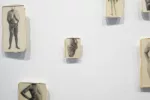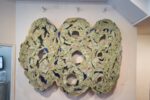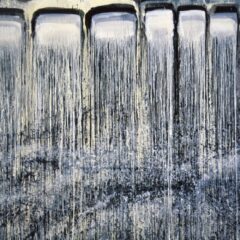Although Emma Wilcox photographs urban decay, the photographer’s work is more than nostalgic yearning for the past. Her silver gelatin prints at the Print Center highlight her engagement with photography’s historic and contemporary applications — as well as her ongoing engagement with Newark, NJ where she lives. Working within the tradition of street photography, Forensic Landscapes is an ongoing series of Newark’s deterioration. In the more contemporary body of work, Where It Falls, photography is used to document her text-based interventions on rooftops in Newark. A third group of works, Promesas, selected by the artist, shows historical documents and art relating to Newark and the issue of gentrification.
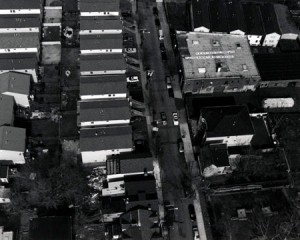
After her home was seized under the eminent domain laws to make way for a new development, Wilcox began her series of text-based interventions on Newark’s rooftops, which she later photographs from a helicopter. Written in twelve-foot-tall letters, using a mixture of flour and paint, the statements are pithy and aggressive but also mournful, acknowledging the victims’ loss. “MY MEMORY GETS IN THE WAY YOUR HISTORY” [sic] expands the conversation from ownership and land use to the historical ramifications of collective memory versus individual accounts. This loss of history is also given visual form with the omission of the word “of” in the statement. “A BLACK OAK TREE + A SMALL OAK TREE” acknowledges environmental loss from development. In another photo, “THIEF” is written on the ground with a pointing arrow that questions the justness of eminent domain and its rationale of being for the public good.
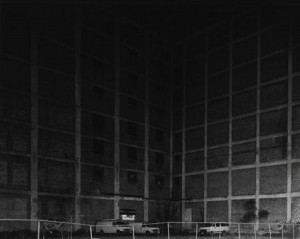
In contrast to the aerial photographs, the Forensic Landscapes are at ground level focusing more on the city’s physical deterioration. Silver gelatin printing provides a rich blackness not possible with digital prints. The darkness of the images obscures parts of the photographs, lending each work a sense of uncertainty or impending danger. In “Local,” the top of the photograph is weighed down by an ominous blackness. The tight framing of a parking lot between two towering walls of what looks like a warehouse also adds to the feeling of claustrophobia and entrapment, and the great distance between the viewer and the parking lot suggests cautious observance. While Wilcox’s interventionist techniques make Where It Falls the more compelling series of photographs, the two bodies of work complement each other to go beyond photography’s documentary function.

Many of the objects in Promesas reflect the history of urban planning in Newark, while others are concerned with issues that affect urban areas: gentrification, poverty, and the presence of diverse communities. Historical documents about neighborhoods and communities are placed within a vitrine. Articles detail the role that artists have in the creation of communities. On the wall, the broadside “On Making a City to Be Proud of” is a call to the city’s occupants to do their part to serve the best interests of Newark through honest and diligent labor. Published in 1913 when Newark was a prosperous manufacturing center, the sole prescription of honest and diligent work now seems like a naive solution.
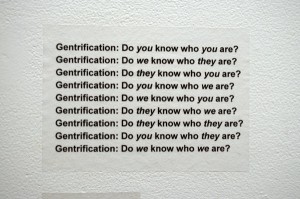
Rosamond S. King’s nearby work “Gentrification is…” points out the identity politics surrounding the process of urban change through development. The component of the work that hangs on the wall highlights the “us versus them” mentality by repeating a series of similarly-structured questions that aim to identify each group. On the floor, a series of take-away, paper fortunetellers provides a variety of definitions for gentrification including “Gentrification is when crime goes down and the police become friendlier,” and “Gentrification is when ‘visible’ artists (usually white and/or strangely dressed) move into a neighborhood where ‘invisible’ artists may already live.” Fittingly, the opposite side of each fortuneteller is a map of Philadelphia.
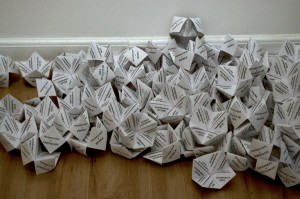
Emma Wilcox is not simply a photo documentarian acting as a passive observer to the problems of Newark. More so than Where It Falls, her series Forensic Landscapes works within this tradition of documentary photography to record a scarred landscape. However, Wilcox usurps a position of power with her aerial photographs in Where It Falls. Her text-based works are not only activist statements, but also, marks on the landscape, given permanence through each photograph. By marking the landscape, Wilcox makes her disenfranchisement in the face of eminent domain visible and alludes to the countless other marks on the landscape that have been forgotten or ignored.
Where It Falls is on view at The Print Center until July 28. The Print Center will produce an accompanying publication with related historical and contemporary materials and an essay by author Luc Sante. Thursday, May 31, 6:00pm, Panel Discussion: Emma Wilcox with Damon Rich and John Caperton. FREE



